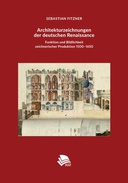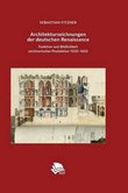Explore

Architekturzeichnungen Der Deutschen Renaissance
Sebastian Fitzner
2015
Architekturzeichnungen sind nicht nur Medien zur Planung und Visualisierung von Architektur, sondern bedeutende Quellen historischer Entwurfstheorien, Entwurfspraktiken und Wissensproduktion. Während italienische Architekturzeichnungen etablierte Quellen der Renaissanceforschung sind, wird hier erstmals der Blick auf bislang vernachlässigte Zeichnungen der ›deutschen Renaissance‹ gelegt. Die vorliegende Studie untersucht sowohl die zeichnerischen Darstellungstechniken und Theorien als auch ihre allgemeine Bedeutung als Form- und Wissensspeicher. Der Autor analysiert dabei etwa die variable Verwendung der Zeichnungen vom Entwurfsmedium über das Rechtsdokument bis hin zur Prinzenerziehung und hebt den Stellenwert von Zeichnung und Zeichnungstheorie für verschiedene Professionen sowie das Selbstverständnis der Architekten hervor. Zudem werden erste Einblicke in die fürstliche und reichsstädtische Sammlungsgeschichte von Architekturzeichnungen in Kunstkammern, Bibliotheken und Kanzleien gegeben. Anhand von exemplarischen Fallstudien und neu erschlossenem Quellenmaterial werden so nicht nur neue Einsichten in die Funktionen und Semantiken zeichnerischer Produktion eröffnet, sondern auch übergreifende Fragen der historischen Wahrnehmung von Architektur in der Frühen Neuzeit verhandelt.Sebastian Fitzner wurde 2013 im Fach Kunstgeschichte an der Ludwig-Maximilians-Universität bei Prof. Dr. Stephan Hoppe promoviert und war wissenschaftlicher Assistent am Institut für Kunstgeschichte der LMU (2010–2014). Zuvor war er wissenschaftlicher Mitarbeiter an der Sächsischen Landesbibliothek ‒ Staats- und Universitätsbibliothek Dresden (SLUB) im Rahmen des DFG-Projekts »Architektur- und Ingenieurzeichnungen der deutschen Renaissance. Digitalisierung und wissenschaftliche Erschließung des Zeichnungsbestandes von 1500‒1650« (2009–2010) und Mitglied des DFG-Forschungsnetzwerkes Schnittstelle Bild. Architekturgeschichte und Bildkritik im Dialog 1400–1800. Aktuell ist er Juniorprofessor für Architekturgeschichte und Architekturtheorie der Frühen Neuzeit in Europa und Amerika (1500–1800) am Kunsthistorischen Institut der Freien Universität Berlin.Beiträge zu seiner Forschung veröffentlicht er unter anderem in seinem Blog »ArchitecturalDrawings – Images and Representations of Architecture in the Early Modern Period«.Webseite: http://fu-berlin.academia.edu/SebastianFitzner
This book is included in DOAB.
Why read this book? Have your say.
You must be logged in to comment.
Rights Information
Are you the author or publisher of this work? If so, you can claim it as yours by registering as an Unglue.it rights holder.Downloads
- 56 - mobi (CC BY) at Unglue.it.
- 61 - epub (CC BY) at Unglue.it.
- 54 - pdf (CC BY) at Unglue.it.
Keywords
- 1600
- Architectural drawing
- Architecture
- Architektur
- Architekturzeichnung
- Art forms
- Castles & fortifications
- Drawing & drawings
- Education
- Erziehung und Bildung
- History of art & design styles: c 1400 to c 1600
- History Of Art / Art & Design Styles
- Palaces, chateaux, country houses
- renaissance 1400
- Renaissance 1400-1600
- Renaissance 1400–1600
- Renaissance Art
- Residential buildings, domestic buildings
- The arts
- thema EDItEUR::6 Style qualifiers::6R Styles (R)::6RC Renaissance style
- thema EDItEUR::A The Arts::AF The Arts: art forms::AFF Drawing and drawings
- thema EDItEUR::A The Arts::AG The Arts: treatments and subjects::AGA History of art
- thema EDItEUR::A The Arts::AM Architecture
- thema EDItEUR::A The Arts::AM Architecture::AMK Architecture: residential and domestic buildings::AMKL Architecture: castles and fortifications
- thema EDItEUR::A The Arts::AM Architecture::AMK Architecture: residential and domestic buildings::AMKS Architecture: palaces, stately homes and mansions
- Visual Culture
- Visuelle Kultur
- Zeichnung (Architektur)
- Zeichnung (Kunst)
Links
DOI: 10.16994/bacweb: http://www.humanities-map.net/site/books/10.16994/bac/
Editions




